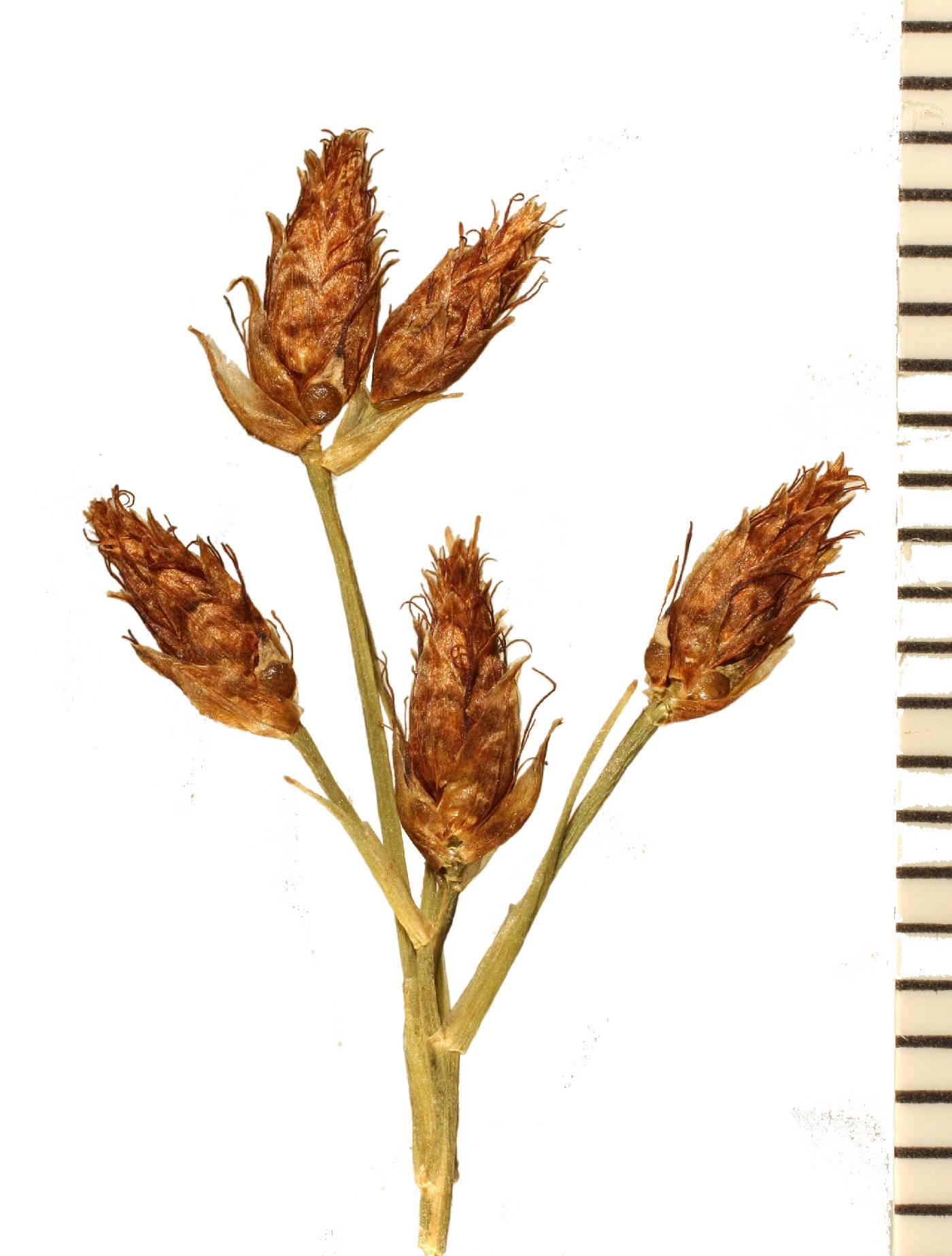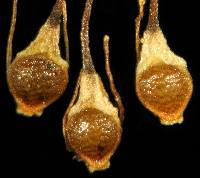|
|
|
|
Family: Cyperaceae
longbeak beaksedge
[Psilocarya corymbifera (C.Wright) Benth., morePsilocarya corymbiformis Benth. & Hook.f., Psilocarya scirpoides Torr., Psilocarya scirpoides var. grimesii Fernald & Griscom] |
Plants annual, cespitose, (20-)30-80(-100) cm; rhizomes absent. Culms erect or ascending, leafy, nearly terete or obscurely angular, many-ribbed, stiff. Leaves exceeding or exceeded by inflorescences; blades linear, proximally flat, 1-5 mm wide, apex trigonous, tapering. Inflorescences terminal and axillary, clusters of corymbs 1-5, diffuse, branches ascending to divaricate; leafy bracts much exceeding axillary corymbs. Spikelets red brown to dark brown, ovoid lanceoloid, 3-6(-7) mm, apex acute; fertile scales several, narrowly ovate, 2.5-3.5 mm, apex narrowly acute; midrib included or short excurrent. Flowers: perianth absent. Fruits 1.3-1.5 mm; body brown to blackish, tumidly lenticular, nearly orbicular, 0.6-1 × 0.6-1 mm, margins distinct, narrow, flowing into base of tubercle; tubercle flat, narrowly triangular, at least 0.5 mm high, base broadly 2-lobed, apex acuminate. Fruiting summer-fall or all year (south). Moist to wet sands or peats of banks of streams and ditches, pond and lakeshores, depressions in savannas, marshes, often in moist to wet disturbed areas; 0-200 m; Ala., Conn., Del., Fla., Ga., Ind., La., Md., Mass., Mich., Miss., N.J., N.Y., N.C., R.I., S.C., Tex., Va., Wis.; West Indies. Annual herb, tufted 20 cm - 1 m tall Leaves: alternate, three-ranked, 1 - 5 mm wide, flat basally, linear with a tapering and three-sided tip, parallel-veined, with a sheathing base that encloses the stem. Sheaths opening at the top. Inflorescence: a loosely clustered group of one to five spikelet clusters, terminal and axillary, subtended by leaf-like bracts. Spikelet clusters cylindrical to egg-shaped. Flowers: minute, subtended by a floral scale, lacking sepals and petals. Stamens one or two, exserted. Pistil one. Style two-cleft. Fruit: a one-seeded achene, brown to blackish, 0.5 - 1 mm long (not including tubercle), 0.5 - 1 mm wide, more or less round, biconvex, wrinkled, with distinct narrow margins. Tubercle tiny, flattened, narrowly triangular with a broadly two-lobed base. Culm: upright to ascending, 20 cm - 1 m long, nearly circular in cross-section or angled, ribbed, solid, leafy. Spikelets: reddish brown to dark brown, 3 - 6 mm long, lance-shaped to egg-shaped with a pointed apex. Floral scales spirally arranged and overlapping, 2.5 - 3.5 mm long, narrowly egg-shaped with a pointed apex, one-ribbed, thin. Similar species: No information at this time. Flowering: August to early October Habitat and ecology: Rare in the Chicago Region and currently only found in the eastern sector. There it grows in moist areas having mineral sand. Occurence in the Chicago region: native Etymology: Rhynchospora comes from the Greek words rhynchus, meaning beak, and spora, meaning seed, referring to the beaked achene. Scirpoides refers to the genus Scirpus. Author: The Morton Arboretum Tufted annual 1-6 dm; blades 1-3 mm wide; spikes ovoid to cylindric, 3-7 mm, loosely clustered at the ends of the stem and branches; scales numerous, thin, 1-nerved, ovate, acute, 3 mm, each subtending a perfect fl, perianth wanting; stamens 1 or 2; achenes 0.7-1 mm, rotund or a little wider than long, contracted to a short broad stipe, longitudinally finely striate and sometimes obscurely cross-rugulose, pale brown, becoming nearly black, with raised pale margins; tubercle flat, triangular-subulate, nearly or quite as long as the achene. Wet sandy soil; e. Mass. and R.I.; nw. Ind. and sw. Mich.; se. Va. to e. N.C. (Psilocarya s.) Gleason, Henry A. & Cronquist, Arthur J. 1991. Manual of vascular plants of northeastern United States and adjacent Canada. lxxv + 910 pp. ©The New York Botanical Garden. All rights reserved. Used by permission. |




